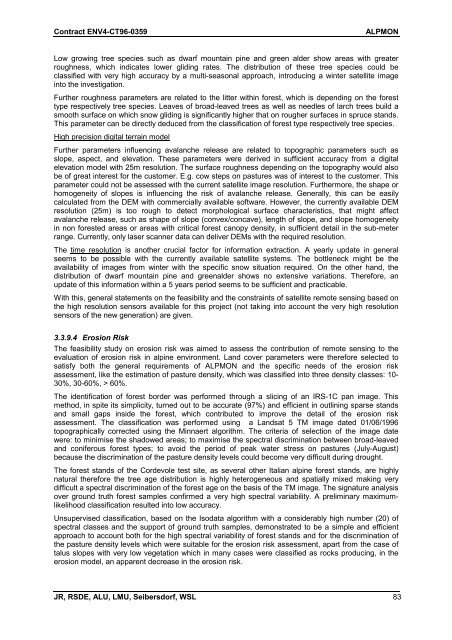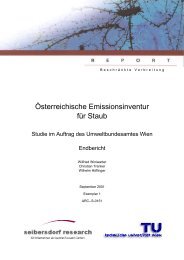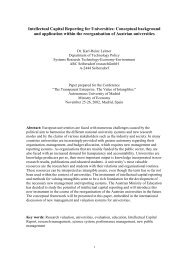ALPMON FINAL REPORT - ARC systems research
ALPMON FINAL REPORT - ARC systems research
ALPMON FINAL REPORT - ARC systems research
Create successful ePaper yourself
Turn your PDF publications into a flip-book with our unique Google optimized e-Paper software.
Contract ENV4-CT96-0359 <strong>ALPMON</strong><br />
Low growing tree species such as dwarf mountain pine and green alder show areas with greater<br />
roughness, which indicates lower gliding rates. The distribution of these tree species could be<br />
classified with very high accuracy by a multi-seasonal approach, introducing a winter satellite image<br />
into the investigation.<br />
Further roughness parameters are related to the litter within forest, which is depending on the forest<br />
type respectively tree species. Leaves of broad-leaved trees as well as needles of larch trees build a<br />
smooth surface on which snow gliding is significantly higher that on rougher surfaces in spruce stands.<br />
This parameter can be directly deduced from the classification of forest type respectively tree species.<br />
High precision digital terrain model<br />
Further parameters influencing avalanche release are related to topographic parameters such as<br />
slope, aspect, and elevation. These parameters were derived in sufficient accuracy from a digital<br />
elevation model with 25m resolution. The surface roughness depending on the topography would also<br />
be of great interest for the customer. E.g. cow steps on pastures was of interest to the customer. This<br />
parameter could not be assessed with the current satellite image resolution. Furthermore, the shape or<br />
homogeneity of slopes is influencing the risk of avalanche release. Generally, this can be easily<br />
calculated from the DEM with commercially available software. However, the currently available DEM<br />
resolution (25m) is too rough to detect morphological surface characteristics, that might affect<br />
avalanche release, such as shape of slope (convex/concave), length of slope, and slope homogeneity<br />
in non forested areas or areas with critical forest canopy density, in sufficient detail in the sub-meter<br />
range. Currently, only laser scanner data can deliver DEMs with the required resolution.<br />
The time resolution is another crucial factor for information extraction. A yearly update in general<br />
seems to be possible with the currently available satellite <strong>systems</strong>. The bottleneck might be the<br />
availability of images from winter with the specific snow situation required. On the other hand, the<br />
distribution of dwarf mountain pine and greenalder shows no extensive variations. Therefore, an<br />
update of this information within a 5 years period seems to be sufficient and practicable.<br />
With this, general statements on the feasibility and the constraints of satellite remote sensing based on<br />
the high resolution sensors available for this project (not taking into account the very high resolution<br />
sensors of the new generation) are given.<br />
3.3.9.4 Erosion Risk<br />
The feasibility study on erosion risk was aimed to assess the contribution of remote sensing to the<br />
evaluation of erosion risk in alpine environment. Land cover parameters were therefore selected to<br />
satisfy both the general requirements of <strong>ALPMON</strong> and the specific needs of the erosion risk<br />
assessment, like the estimation of pasture density, which was classified into three density classes: 10-<br />
30%, 30-60%, > 60%.<br />
The identification of forest border was performed through a slicing of an IRS-1C pan image. This<br />
method, in spite its simplicity, turned out to be accurate (97%) and efficient in outlining sparse stands<br />
and small gaps inside the forest, which contributed to improve the detail of the erosion risk<br />
assessment. The classification was performed using a Landsat 5 TM image dated 01/06/1996<br />
topographically corrected using the Minnaert algorithm. The criteria of selection of the image date<br />
were: to minimise the shadowed areas; to maximise the spectral discrimination between broad-leaved<br />
and coniferous forest types; to avoid the period of peak water stress on pastures (July-August)<br />
because the discrimination of the pasture density levels could become very difficult during drought.<br />
The forest stands of the Cordevole test site, as several other Italian alpine forest stands, are highly<br />
natural therefore the tree age distribution is highly heterogeneous and spatially mixed making very<br />
difficult a spectral discrimination of the forest age on the basis of the TM image. The signature analysis<br />
over ground truth forest samples confirmed a very high spectral variability. A preliminary maximumlikelihood<br />
classification resulted into low accuracy.<br />
Unsupervised classification, based on the Isodata algorithm with a considerably high number (20) of<br />
spectral classes and the support of ground truth samples, demonstrated to be a simple and efficient<br />
approach to account both for the high spectral variability of forest stands and for the discrimination of<br />
the pasture density levels which were suitable for the erosion risk assessment, apart from the case of<br />
talus slopes with very low vegetation which in many cases were classified as rocks producing, in the<br />
erosion model, an apparent decrease in the erosion risk.<br />
JR, RSDE, ALU, LMU, Seibersdorf, WSL 83




